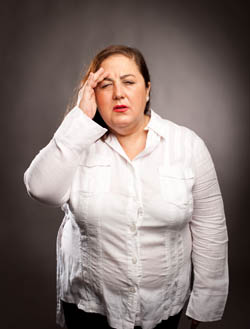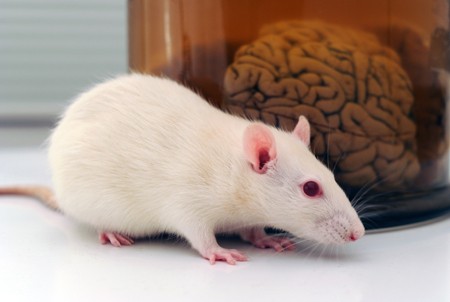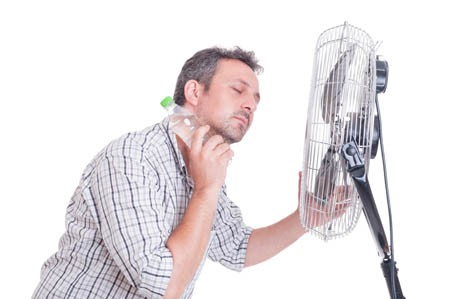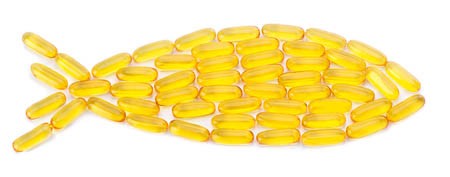Drug Reduces Agitation in Patients with Alzheimer’s
Agitation is common among people with Alzheimer’s dementia. A 2015 phase 2 clinical trial by Jeffrey L. Cummings and colleagues, which was published in the journal JAMA, found that a combination of the drugs dextromethorphan hydrobromide and quinidine sulfate called Nuedexta reduced agitation significantly compared to placebo in patients with probable Alzheimer’s disease over a period of 10 weeks. Dextromethorphan-quinidine was dosed at 20mg/10mg in the morning for one week, then twice daily in weeks 2 and 3, then increased to 30mg/10mg twice daily for weeks 4 and 5. Side effects included falls, diarrhea, and urinary tract infections. Dextromethorphan-quinidine did not cause cognitive impairment, sedation, or irregularities in heart rate.
Changes in Sense of Humor May Be Warning Sign of Dementia
 A change in a person’s sense of humor could be an early indicator of dementia, according to a 2015 article by Jason Warren and colleagues in the Journal of Alzheimer’s Disease. The changes can appear as early as 10 years before a diagnosis of dementia. Almost all participants who would go on to be diagnosed with frontotemporal dementia showed an increased preference for slapstick humor over satirical or absurdist compared with those who would not. In contrast, changes in sense of humor appeared in less than half of those who would go on to be diagnosed with Alzheimer’s disease, indicating that changes in sense of humor may allow doctors to distinguish between different types of dementia.
A change in a person’s sense of humor could be an early indicator of dementia, according to a 2015 article by Jason Warren and colleagues in the Journal of Alzheimer’s Disease. The changes can appear as early as 10 years before a diagnosis of dementia. Almost all participants who would go on to be diagnosed with frontotemporal dementia showed an increased preference for slapstick humor over satirical or absurdist compared with those who would not. In contrast, changes in sense of humor appeared in less than half of those who would go on to be diagnosed with Alzheimer’s disease, indicating that changes in sense of humor may allow doctors to distinguish between different types of dementia.
The study has some limitations. It was small (48 patients) and relied on patients’ memory of what kind of humor they enjoyed 15 years earlier. More research is needed to clarify the link between changes in humor preferences and dementia.
Warren suggests that changes in humor appear before other warning signs of dementia, such as memory loss. He called humor a type of “stress test” for the brain, since getting a joke can require a quick shift in perspective.
Memory Activates Epigenetic Changes in Mice Brain Cells
In a 2015 article in Nature Neuroscience, Stefan Bonn and André Fischer reported that when mice were prompted to use their long-term memory to recognize a specific environment, epigenetic changes occurred in their neurons and glia. Epigenetic changes refer to chemical alterations in DNA or histones (which give DNA structure) that increase or decrease the expression of certain genes. Sometimes environmental factors lead to a methyl or acetyl group joining a strand of DNA or histones, changing how easily the genes are turned on or off.
When the mice used their long-term memory, the main change that occurred was DNA methylation in their neurons. There were also changes to histones that were linked to memory acquisition but resulted in few changes in gene expression. The DNA methylation changes, on the other hand, changed neural pathways, leading to “rewiring” of the brain.
Light Therapy Effectively Treats Non-Seasonal Depression
Doctors have known for some time that treatment with high-intensity light (7,000–10,000 Lux) can improve seasonal depression. In an 8-week study published in the journal JAMA Psychiatry in 2015, researcher Raymond Lam compared four different treatment options for non-seasonal major unipolar depression: bright light therapy for 30 minutes per day first thing in the morning, 20 mg of the antidepressant fluoxetine per day, combined bright light therapy and fluoxetine, and a placebo device paired with a placebo pill.
The combination of bright light therapy and fluoxetine produced remission in 58.6% of the participants who received it, compared to remission rates of 43.8% for bright light alone, 19.4% for fluoxetine alone, and 30% for placebo. It is notable that the effects of fluoxetine did not exceed those of placebo, but the effects of light alone did. There were few side effects in any group.
These data provide convincing evidence of the efficacy of light therapy in the treatment of non-seasonal unipolar depression. Use of light therapy for non-seasonal depression should now be more routinely considered, particularly when combined with antidepressant treatment.
Patients who had previously failed to respond to two or more antidepressants and patients with bipolar depression were excluded from the study. Bright light therapy administered in the morning can sometimes bring about mixed states in people with bipolar disorder. A 2007 case study by D. Sit and colleagues in the journal Bipolar Disorders found that midday light led to more improvement and less risk of mixed states than morning light among women with bipolar disorder.
Music, Mindfulness and Exercise Improve Brain Functioning
Psychiatrists should take the lead in endorsing general wellness and encouraging healthy behaviors, says researcher James Hudziak. He suggests that opportunities to practice music, mindfulness, and exercise should be made available to all school children to increase brain health, and that more intensive efforts are necessary for children in families that are at risk for mood and behavioral difficulties or in children who show some dysfunction in these areas. Hudziak has implemented a statewide program in Vermont that encourages families to engage in these healthy practices.
Hudziak and colleagues analyzed brain scans of 232 children ages 6 to 18, looking for relationships between cortical thickness and musical training. They found that practicing an instrument such as the piano or violin increased working memory, gray matter volume in the brain, and the ability to screen out irrelevant noise. Practicing mindfulness increased white matter volume and reduced anxiety and depression. Exercise also increased brain volume and neuropsychological abilities.
Now Hudziak urges parents to advocate for the teaching of music, mindfulness, and exercise in schools as a way of improving general health, especially since music and gym are often the first programs to be cut when schools face budget shortages. Hudziak suggests that opportunities for athletics should be provided to all children, independent of their skill level, rather than only for the best athletes who “make the team.” Intramural teams should be open to all children, including those with less ability or minimal athletic skills. Exercise, teamwork, and friendships benefit all children.
For more information about the programs Hudziak implemented in Vermont, use the internet to search for the Vermont Family Based Approach, see his book Developmental Psychopathology and Wellness: Genetic and Environmental Influences, or call the University of Vermont Medical Center at (802)847-0000 or (800)358-1144.
Another tool that may be useful to parents of children aged 2 to 12 who are at risk for mood disorders is our Child Network, a secure online portal where parents can complete quick weekly ratings of their child’s mood and behavior, which is then graphed over time and can be used to show the child’s doctors how his or her symptoms are fluctuating and how well any treatment is working.
Cool News: Raising Body Temperature Can Relieve Depression
Raising body temperature by a few degrees may produce antidepressant effects as the body’s cooling mechanisms kick in. At the US Psychiatric and Mental Health Congress in 2015, researcher Charles Raison described a study comparing the effects of exposing participants to a special heating coil in a tent that retained the heat until their body temperatures increased by a few degrees to those of a sham procedure that did not raise body temperature. Those participants whose body temperature was increased had a lower body temperature the following day, and their depression improved as their bodies cooled. These improvements lasted six weeks or more.
Depressed patients tend to have elevated body temperatures. Raison suggests that raising body temperatures even more prompts the body’s cooling mechanisms to compensate, bringing cooling activity to normal levels from the skin to the brain and improving depression.
Depression and Obesity Linked in Study of Mexican Americans
 A 2015 study by Rene L. Olvera and colleagues in the Journal of Clinical Psychiatry indicated that among 1,768 Mexican-Americans living along the border from 2004–2010, 30% were currently depressed, 14% had severe depression, and 52% were obese. Women were more likely to be depressed, and more likely to have severe depression. Other factors making depression more likely included low education, obesity, low levels of “good” cholesterol, and larger waist circumference. Low education and extreme obesity were also linked to severe depression.
A 2015 study by Rene L. Olvera and colleagues in the Journal of Clinical Psychiatry indicated that among 1,768 Mexican-Americans living along the border from 2004–2010, 30% were currently depressed, 14% had severe depression, and 52% were obese. Women were more likely to be depressed, and more likely to have severe depression. Other factors making depression more likely included low education, obesity, low levels of “good” cholesterol, and larger waist circumference. Low education and extreme obesity were also linked to severe depression.
In a commentary on the article in the same issue, researcher Susan L. McElroy wrote that “the medical field needs to firmly accept that obesity is a risk factor for depression and, conversely, that depression is a risk factor of obesity.” She suggested that people with obesity, those who carry excess weight around their middles, and those who have related metabolic symptoms such as poor cholesterol should all be evaluated for depression. Likewise, those with depression should have their weight and body measures monitored. People with both obesity and depression should be evaluated for disordered eating.
Successful Double-Blind Placebo-Controlled Study of Lithium for Acute Mania in Kids 7–17
Lithium is the treatment of choice for adults with bipolar disorder, but has rarely been studied in children or adolescents. One of the first double-blind placebo-controlled trials of lithium for the treatment of mania in children and teens aged 7–17 showed that the drug produced greater improvement in mania than did placebo. Side effects included blurred vision, abdominal pain, diarrhea, nausea, vomiting, fatigue, thirst, increased thyroid-stimulating hormone, decreased appetite, dizziness, sedation, tremor, increased urination, and rash.
In the study by researcher Adelaide S. Robb and colleagues, which was presented at the 2015 meeting of the American Academy of Child and Adolescent Psychiatry, doses began at 300mg twice a day, were based on each child’s weight, and were slowly increased.
At the same meeting, researcher Russell Scheffer presented data on 41 children who continued lithium treatment for 16 weeks with good results. The mean dose was 27.8 +/- 6.7 mg/kg per day.
Diagnosing PANS
Pediatric Acute-Onset Neuropsychiatric Syndrome, or PANS, describes a condition in which a child develops acute onset of psychiatric symptoms following an infection. At the 2015 meeting of the American Academy of Child and Adolescent Psychiatry, researcher Tanya K. Murphy reported on symptoms that differentiate PANS from other childhood-onset illnesses. Kids with PANS are more likely to have:
- sudden onset of symptoms
- earlier age of onset
- personality changes
- new onset of attention deficit hyperactivity disorder (ADHD) symptoms
- food refusal and weight loss
- behavioral regression
- deterioration in handwriting
- severe sleep disruption
- psychosis
- memory problems
- frequent urination
- dilated pupils
- an infection at the time of onset, particularly a group A streptococcal infection
A child with sudden onset of these symptoms following an infection may have PANS. It is important to differentiate PANS from traditional psychiatric diagnoses because treatment of PANS often consists of antibiotics, anti-inflammatory medications, and other treatments that target the immune system. See our case report about a boy with PANS.
Omega-3 Fatty Acids Associated with Small Improvement in Depression in Children Aged 7–14
At the 2015 meeting of the American Academy of Child and Adolescent Psychiatry, researcher Mary A. Fristad reported that omega-3 fatty acid supplements had a small beneficial effect on depression in children aged 7–14. The supplements did not noticeably improve bipolar disorder not otherwise specified (NOS) or mania. The supplements consisted of several types of omega-3 fatty acids, including 1400mg of EPA, 200mg of DHA, and 400mg of others per day. The children were also undergoing psychotherapy during the study.









